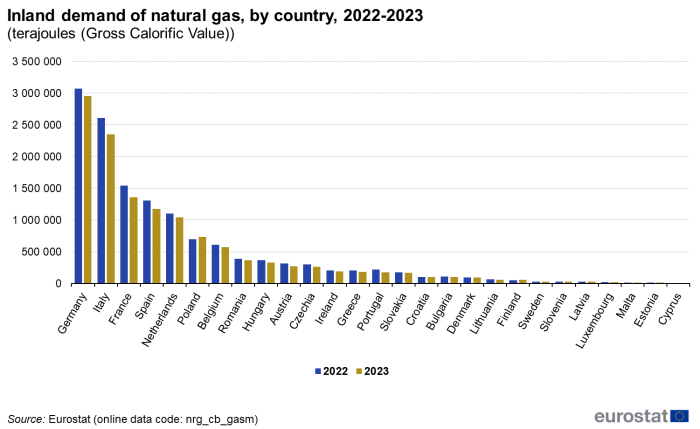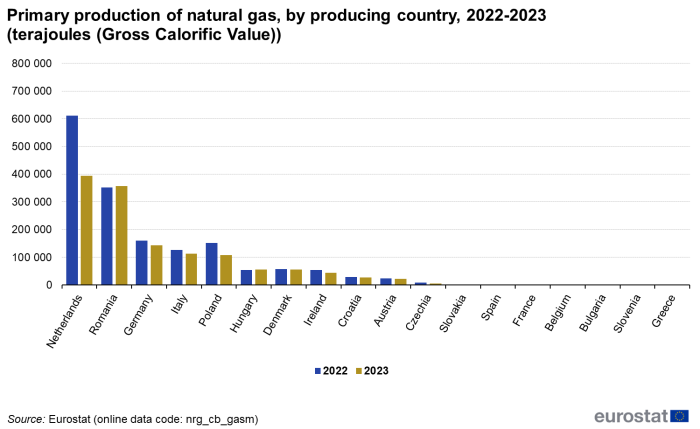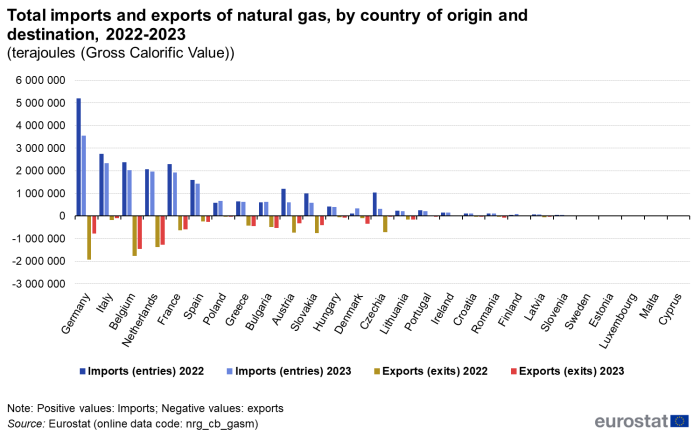Natural gas supply statistics
Data from May 2024.
Planned article update: 30 May 2025.
Highlights
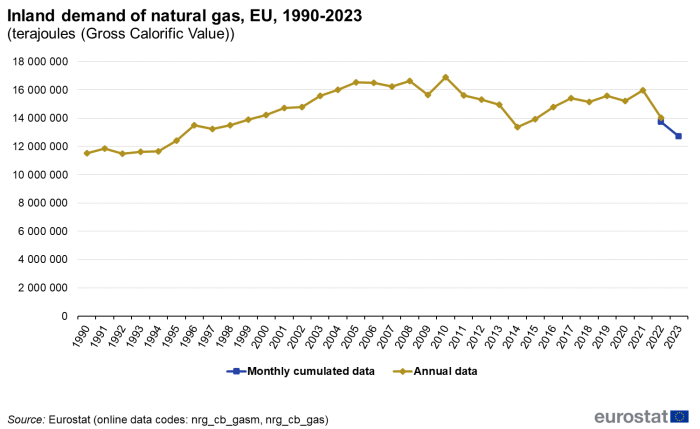
in terajoules (gross calorific value)
Source: Eurostat (nrg_cb_gasm), (nrg_cb_gas)
This article looks at monthly cumulated data on natural gas in the European Union (EU) for 2022 and 2023, as well as changes between these two years. It covers all aspects of the supply side - primary production, imports (entries) and exports (exits), stock changes, inland demand - as well as natural gas energy dependency data by EU Member State and for the European aggregates, i.e. the EU and euro area.
Full article
Consumption trends
In 2023, inland demand of natural gas in the EU decreased by 7.1 % compared with 2022, to drop to 12 719 409 terajoules. The largest increases in consumption were recorded in Finland (25.6 %), Sweden (11.1 %) and Poland (5.2 %), while the largest drops occurred in Portugal (20.2 %), Austria (13.2 %) and Czechia (11.9 %). In 2022, Germany, Italy and France had the highest inland demand with 2 956 782 terajoules, 2 351 303 terajoules and 1 362 744 terajoules respectively (see Table 1, Table 2 and Figure 2).
In Table 1 and Table 2, a negative dependency rate indicates a net exporter country. Positive values over 100 % indicate stocks build-up during the reference period.
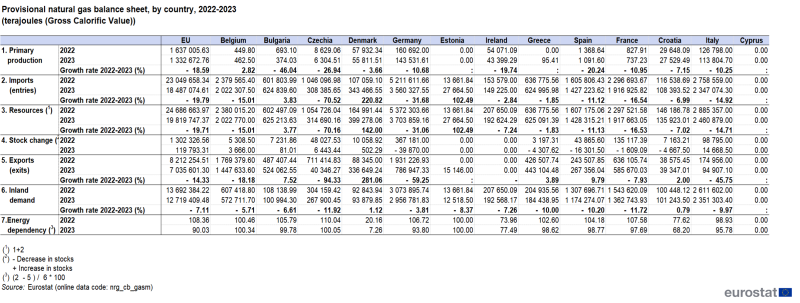
Source: Eurostat (nrg_cb_gasm)
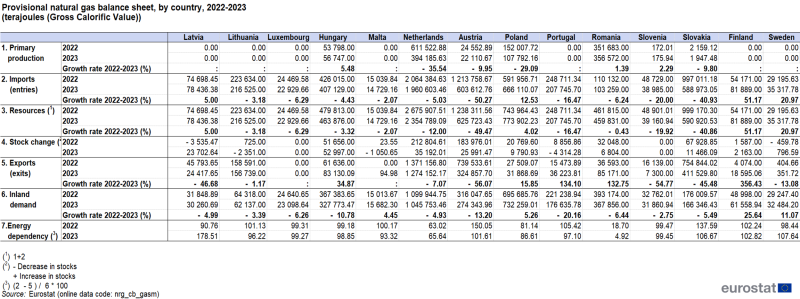
Source: Eurostat (nrg_cb_gasm)
Supply structure
Natural gas production
EU natural gas production continued its decreasing trend, falling by 18.6 % in 2023 compared with 2022, to 1 332 673 terajoules. The main EU natural gas producer, the Netherlands, registered a drop in production of 35.5 %. With a natural gas production of 394 186 terajoules in 2023, the Netherlands remained the highest producer of natural gas in the EU, followed by Romania, whose primary production equaled 356 572 terajoules (an increase of 1.4 %), and Germany, whose primary production was 143 532 terajoules (a decrease of 10.7 %) (see Figure 3).
Natural gas imports
Total EU imports of natural gas decreased by 19.8 % to reach 18 487 075 terajoules. The most significant increases in 2023 compared with 2022 among the main importers, i.e., countries importing at least 500 000 terajoules, was observed in Poland (12.5 %) and Bulgaria (3.8 %) whereas the main decreases were recorded in Austria (-50.3 %), Slovakia (-40.9 %) and Germany (-31.7 %) (see Figure 4).
It is important to remember a methodological change in reporting monthly natural gas trade since reference month January 2013. The monthly reporting provides import figures as entries from the last transit country (mostly neighbouring countries) instead of the country of origin (i.e. the country of primary/indigenous production) and export figures as exits from the reporting country (thus including all natural gas transiting its national territory). This is different from the methodology for annual data, where the ultimate origin of imports is reported, thus excluding all natural gas transit, also from export figures.
Source data for tables and graphs
Data sources
All data used in this article correspond to cumulative monthly figures and may differ from the annual data.
The reporting is based on Regulation (EC) No 1099/2008 on energy statistics.
Context
Timely data are essential to all stakeholders for an efficient monitoring of the market evolutions, especially in the energy domain. Therefore, Eurostat not only collects detailed annual statistics but also complements them with a reduced number of data points collected on a monthly basis. The reporting deadline for countries to transmit monthly natural gas statistics to Eurostat is within 55 days after the end of the reference month. Eurostat validates received data and publishes them as soon as validated. In this framework, the natural gas monthly data covers its supply – and to a limited extent its consumption, thus providing early information about the developments in the natural gas market both in the EU and in each Member State.
Direct access to
- Energy, transport and environment indicators - 2020 edition
- Energy Statistics - quantities (t_nrg_quant)
- Gross available energy by product (ten00121)
- Final energy consumption by product (ten00123)
- Energy dependence (t2020_rd320)
- Energy Statistics - quantities, monthly data (nrg_quant)
- Energy Statistics - supply, transformation, consumption (nrg_10m)
- Supply - gas - monthly data (nrg_103m)
- Energy statistics - imports (by country of origin) (nrg_12m)
- Imports (by country of origin) - gas - monthly data (nrg_124m)
- Energy statistics - exports (by country of destination) (nrg_13m)
- Exports (by country of destination) - gas - monthly data (nrg_134m)
- Energy Statistics - supply, transformation, consumption (nrg_10m)
- Energy statistics - supply, transformation, consumption (monthly) (ESMS metadata file — nrg_10m_esms)
- Regulation (EC) No 1099/2008 on energy statistics
Visualisations
- Explore monthly energy data - This interactive tool helps you to obtain an overview of seasonal energy trends in Europe or your country.
- Discover the world of energy trade - With this interactive tool you can easily discover the main trading partners of your country and visualise the trade flows in different ways.
